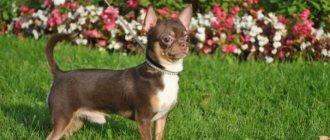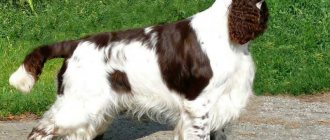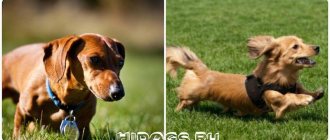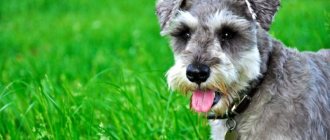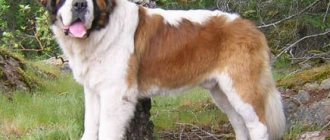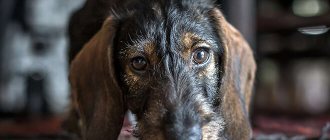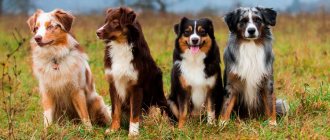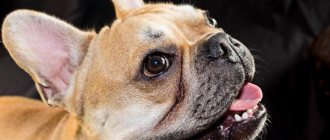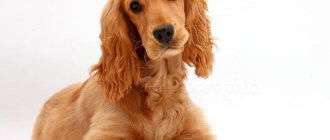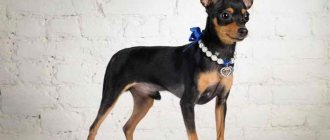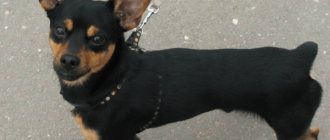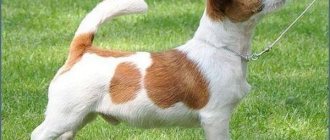Breed description, standards and appearance
Germany is recognized as the birthplace of the breed, where the dachshund dog is called “Dachshund” (“badger hound”).
The animal received this name thanks to the main object of hunting that ravaged German lands - badgers. Breeders received a new breed in the 16th century during the selection of individuals with short legs among hound marriages. The long body and powerful paws allowed the hunting dachshund to climb into a hole and “smoke out” not only badgers, but also foxes.
The main advantages of the new breed were represented by the following qualities:
- Analytic mind. The dog, left alone with the wild animal, made a decision independently, depending on the situation.
- Compact sizes. The dachshund had no problem chasing and dodging the attacks of hunted prey. Larger breeds were injured in narrow tunnels.
- Fearlessness. The dog was not afraid of large opponents and demonstrated a strong grip.
The dachshund is a strong, heavily boned dog that stands firmly on the ground, with a long, elongated muzzle and long, soft ears. The tail, thick and strong at the base, is set low, usually carried slightly below the line of the back, but when excited it sticks out like an antenna. The main distinguishing feature is short thick legs with prominent muscles.
Long-legged and short-legged, Dachshunds are surprisingly fast, flexible and agile. The physique is strong, muscular with a straight back and high-set head. Regardless of external factors, the dog is attentive, reserved and quite patient. It is commonly said that the Dachshund was created by hunting, that is, the dog must personify determination, courage and readiness to work.
Males and females are distinguishable, but the latter should not look too specific. The size of an adult dog is determined by the usual and additional parameters, regardless of gender:
- Height: 35 cm and above.
- Weight: 7–9 kg, although larger individuals are also found.
- Chest circumference behind the elbows: more than 36 cm.
Why is the chest circumference taken into account and not the basic dimensions of the dachshund? For a standard representative of the breed, it is important to match the proportions; weight and height at the withers do not play a key role. For example, a dog weighing 11–12 kg will be recognized as a purebred dog, especially if we are talking about a male, but such a strong dog cannot be used in work.
A chest that is too wide (proportional to height) is a death sentence for burrow hunting; the Dachshund will simply get stuck in a narrow passage. By the girth of the chest, you can distinguish a dwarf dachshund from a standard one; in the first, the sternum volume varies from 30 to 35 cm. In the smallest rabbit dachshund, the girth is up to 30 cm.
Breed standard
- The head is strong, not heavy, set high and proud. The forehead is moderately convex, not too wide, with a slight furrow. The brow ridges are well defined (but should not distort the silhouette), emphasizing the smooth transition to the front part. The bridge of the nose is narrow and long (in proportion 1:1 to the length of the frontal part), but the muzzle is not pointed. The lines of the head and muzzle are smooth, symmetrical, clearly noticeable when palpated, but smoothed when examined. The lips are of medium thickness, tightly fitting, completely hiding the lower jaw, not drooping. The pigmentation of the lips depends on the color and color saturation; most often the color ranges between black and brown.
- Teeth – perfectly correct bite with strong healthy canines and parallel incisors. The jaws are deep, well developed and should not appear weak. A shortened lower jaw is considered a serious fault.
- The nose is sensitive, developed, oval, fully pigmented.
- Eyes – should not be bulging, round or too large. The shape is oval, standing straight, at a harmonious height and width. The eyelids are tight-fitting, pigmented to match the nose. Eye color ranges from amber to dark brown. In light marbled individuals, blue and lightened iris color is allowed.
- Ears – moderately long, wide, with a triangular (rounded) tip, refracted on cartilage, free from folds. Set not too high, at the level of the forehead line or slightly lower. The tips of the ears are close to the cheekbones when the dog is excited, the ears are raised on the cartilage.
- The body is elongated and squat. The neck is gracefully set with a pronounced scruff, without folds. The withers are well defined, the line of the back is level, slightly sloping towards the elongated loin and sloping croup. Back length in relation to height in proportion 1.7:1. The back should not be hunchbacked or sagging. The chest is elongated and deep. The lowest point of the sternum is raised above the ground by 1/3 of the height at the withers. The ribs are pulled back, the width of the sternum should not exceed the permissible norms and girth. The groin line is moderately tucked and does not restrict movement.
- Limbs – the front legs are very strong, set straight and parallel, the elbows are not turned out or tucked in. The wrists are placed closer than the elbows, which creates the impression of a powerful stance. The hind legs are set confidently, muscular, visually, they look stronger than the front legs, the hock joints are clearly defined. The hands are elongated, oval with long and powerful claws and clenched fingers. The hands of the front and hind paws are placed straight forward, without “spreading”.
- The tail is quite thick, set on the line of the spine, not too high. Carried freely, a slight bend or crescent shape is allowed when the dog is working or enthusiastic.
We invite you to read: Description of the appearance and character of the Bombay cat breed
Coat type and color
Leather Taxelastic, tight-fitting, not forming folds. The coat is short and very thick. The hair on the tail is slightly longer. Extended guard hair is allowed on the back of the tail.
With a common, single-color color in the red palette, an admixture of dark hairs is allowed. By value, colors are considered in the following order:
- Pure, bright and uniform red color.
- Light red and fawn with or without black hairs. Dogs with brown pigmentation on the nose and/or nails.
- Any color with small white markings.
Bi-color colors include black and tan and brown and tan. The first option is more valuable because a brown or lighter tone is considered as weakened pigmentation. Small white spots on the chest are acceptable; unmarked tan or excessive blackening is a fault.
| Age, month | Weight |
| Newborn puppy weight | 200-300 gr |
| Puppy weight 4 weeks (1 month) | 1.1-1.8 kg |
| Puppy weight at 2 months | 2.1-2.9 kg |
| Puppy weight at 3 months | 2.8-4.1 kg |
| Puppy weight at 4 months | 4.1-5.4 kg |
| Puppy weight at 5 months | 5.6-7.1 kg |
| Puppy weight at 6 months | 7.2-8.5 kg |
| Puppy weight at 10-12 months | 7.7-10.4 kg |
Like most newborn puppies, Dachshund puppies are tiny in size, weighing on average 200-250 grams in the case of the Miniature Dachshund. Dachshunds reach their full weight within 1 year. This is a really small dog that can be easily carried around. So if you want a pet that will fit on your lap, the Miniature Dachshund may be the breed for you.
Maintaining a healthy weight is important for all small dogs, and is especially necessary in the case of dachshunds due to their unusually long spine. Dachshunds have a long back and very short legs, which gives them the so-called “hot dog” body type. If they carry too much weight, additional stress will be placed on their spine, which can lead to injury.
Dachshunds are an intelligent and friendly breed, and their size makes them great pets for apartment owners and anyone who doesn't have a strong desire to run around the park every day. Dachshunds need daily exercise, but a short walk will be more than enough.
Standard
The torso is elongated, the muscles are formed, the chest protrudes - larger than the pelvis. The chest smoothly transitions into the stomach. The back is straight, horizontal, not sagging.
The small head is elongated, resembles the shape of a cone, and has strong jaws. The lips are dense, the jaw is tight, the teeth are not visible from the mouth. The teeth are powerful, large fangs, the presence of all teeth is important.
Hanging ears, in the shape of a triangle, fit snugly to the muzzle. Set on high, very mobile. The shape is round, without sharp corners.
Short paws, powerful, fairly wide, with strong claws, pads hard and elastic. The hind limbs are strong, the thigh forms a right angle, the muscles are formed.
A neat tail along the back line. Looks like a saber, without creases, should not form a hook.
The eyes are almond-shaped, dark in color, uniform in color with tinted eyelids.
Wool – long-haired, smooth-haired, wire-haired individuals. Any color is acceptable except albino.
A hunter with a wonderful, cheerful character and a sensitive nose. Moves smoothly and gracefully, movement is free, not constrained.
Dachshund dimensions: height from 14 to 28 cm, weight 4.5 – 12 kg. Chest girth 30-35 cm - for miniature, standard - 35 cm until 15 months is not measured - the dog is growing.
An ideal miniature dachshund weighs up to 4.5 kg; a standard one weighs from 9.5 to 14 kg. Dwarfism according to the London standard is not considered at all, but it is recognized in our country - height at the withers - 14-20 cm, weight - no more than 4 kg for a male, female up to 3.5 kg, we know it as a “rabbit dachshund” chest girth up to 30 cm.
Historical reference
The first ancestors of the breed were depicted on the frescoes of Ancient Egypt approximately 4 thousand years ago. The remains of dachshunds were discovered in the territories of Ancient Greece and Rome. Among dog handlers and scientists, a version-statement has long been formed that Dachshunds are the descendants of the most ancient hunting dogs on our planet. By the way, it is not entirely correct to apply the term “hunting” to the ancestors of four-legged animals; it has been established that these dogs were used as hounds.
The birthplace of the modern breed, without a doubt, is Germany. The age of the earliest remains found in the country is estimated at 3.5–4 thousand years, and the first mention of a dachshund hunter dates back to the 7th century. Since the 8th century, a division of four-legged animals into burrowing (earth) and hounds has appeared. Dogs with elongated bodies and shortened legs appear in both groups. A sharp surge in the popularity of Dachshunds occurred in the 16th century, when burrow hunting served not only as a means of survival, but also as a cultural tradition.
By the 19th century, smooth-haired, wire-haired and long-haired varieties of the breed already existed, but the former is considered the oldest. By 1880, the first breed standard (including all types of coat) and stud book were officially approved in Germany. Over the next 10 years, the quadrupeds began to be separated by size. In the first description of the breed, the weight and size of the dogs were summarized.
The appearance of dwarf and rabbit Dachshunds is due to needs. In sandy areas, the burrows are narrower, and a standard Dachshund would not be able to hunt due to its size. By selecting smaller individuals, people deliberately created a more convenient “model” of a dog. By the beginning of the 20th century, Germany was literally filled with Dachshunds of all types and sizes. In some cities and villages, there were more than 100 dogs per yard! The breed has become a symbol of comfort and the most popular apartment pet.
Breed standard
The standard defines the breed according to 2 characteristics - size and coat.
By size:
By wool type:
There are 9 combinations of these characteristics. For example, a long-haired standard dachshund, a royal purebred, a dwarf smooth-haired or a wire-haired rabbit.
In most breeds, small representatives are not included separately in the standard . Sometimes too small a size or long hair, on the contrary, are recognized as defects at exhibitions.
This is the main difference between the standard for dachshunds - the approved sizes and type of coat.
Factors affecting weight and height
The main influence on the weight of a dachshund is genetic factors. These are followed by ecological, nutritional and environmental factors. Puppies that feed frequently and well on their mother's milk in the first weeks of life are likely to grow at a faster rate.
A puppy's diet after weaning will also significantly affect its rate of growth and weight gain. Young puppies that do not receive adequate nutrition or are fed low-calorie foods may grow smaller.
- The charming short-legged dogs were favorites of the imperial and royal families. For example, the last German Emperor Wilhelm II had 5 dogs of this breed.
- The breed's popularity declined sharply during World War II. In the cartoons, dogs were compared to Nazis, portraying them as aggressive and narrow-minded.
- The Nazis claimed that they had developed a telepathic gift in representatives of the breed.
- The German dog became the second Olympic mascot. Unlike the Red Jaguar from Mexico City, the mascot from Germany received recognition.
- One of the representatives of the breed became a participant in cloning, repeating the experience of the dog Snoopy. The organizers of the project were once again Koreans.
Character and behavior
The brave and decisive character of a dachshund boy makes him a more skillful and proactive hunter. Girls have a softer character than boys, so they are rarely purchased for hunting.
We suggest you familiarize yourself with: Methods of sterilization of cats, age of the pet, preparation and care after surgery
The character of a dachshund has the following traits:
- Devotion. The animal quickly gets used to its new owner and needs constant attention.
- Playfulness. It is difficult for a pet to sit in one place. A restless dog resembles a perpetual motion machine.
- Mind. Developed intelligence. The breed is stubborn and loves to do things its own way, so the OKD course will be a real salvation for the new owner.
- Fearlessness. Despite its modest size, the brave pet is always ready to protect its owner. The main instrument in the dispute is a loud bark, not inferior in volume to larger dogs.
Dachshund and children
Representatives of this breed get along well with children, as they love outdoor games. But do not forget to explain to the kids the rules of behavior with animals.
Infinitely smart and hard-working dogs, at times, show a very daring and uncontrollable character. The reasons always lie in the uncompensated hunting instinct that is inherent in the breed. The fact is that a small, smooth-haired dog is convenient for keeping in an apartment, and confinement within 4 walls and walking twice a day for 15 minutes in no way suits the Dachshund’s temperament.
What happens if your Dachshund can't meet his activity needs? In the easiest case, everything will result in damage to furniture or personal belongings. Runaways are a sore subject for Dachshund owners living in an apartment. The dog simply breaks away and runs “towards adventure”, ignoring the owner’s commands or his pursuit.
A properly raised dog that has the opportunity to run around and burn off energy brings joy to the owner and the whole family. Dachshunds distinguish between friends and strangers, so cats living in your home are not in danger. Rats, ferrets, birds and other animals can arouse hunting interest, but with the right approach on the part of the owner, the dog will get used to the strange neighbor. Relationships with children are going well; even the grumpy Dachshund is patient with the younger generation.
Representatives of the breed quickly learn any discipline, enjoy playing with their relatives and playing sports. Dachshunds also enjoy long, monotonous walks. According to reviews from successful owners, dogs adopt the pace of family life, but require daily exercise.
Pet character
Dachshunds are friendly dogs, suitable as companions and for families with children . Hardy, will withstand long walks for 1-2 hours. Not aggressive towards children.
They need close contact with the owner and often choose a “favorite”. They do not tolerate loneliness well, chew furniture, and howl.
Bred for hunting, they exhibit instincts and chase selected prey while walking . They often run away from their owner in the heat of the chase and get lost. Or they damage furniture and clothes when they dig imaginary holes. This feature is corrected by education.
Dachshunds are successfully trained. They learn circus acts and serious commands with equal success - search, tracking, chasing. These dogs are also stubborn, independent, and sometimes stubborn.
These traits were preserved from their ancestors, because the dog had to calculate some actions on its own.
Capable of protecting the owner . They evaluate their abilities and size before a fight.
Dachshunds have a sonorous and loud bark that does not match their size. Only he alone scares away intruders from a person or from an apartment.
Hunting
The first German name of the breed, Dachshund, speaks for itself, because in direct translation it sounds like one at war with a badger. The breed was bred for burrow work and the appearance of the dogs emphasizes this “trajectory”. It is interesting that every dachshund puppy is born a companion, and then, depending on training, he becomes a miner or a hound.
Traditional burrow hunting includes several stages of training. Dogs train in artificial burrows and learn to escape from opponents' grips. At the same stage, the dog’s courage and its desire to go into the hole are assessed. Training to drive an animal and to feed a wounded animal is fundamentally different, since the four-legged animal should not get into a fight. Controlling aggression towards an animal is a difficult task and not every dog can cope with it.
Character
There is no more cheerful dog, always very playful and positive. Not aggressive towards children and people. A cheerful hunter happily catches a cat on the street or smells a mouse in the next basement. Lover of squirrels and chasing pigeons
Her hound origin gave her speed, the ability to learn quickly, consistency in work, and independence.
Always friendly, protects the owner, fearless in fights. She is often bored at home alone and can howl. From puppyhood, gradually accustom yourself to your absence, starting with 30 minutes and then continuing in an increasing manner.
Cowardice is a deviation from the norm of behavior. He will never refuse food - he can tell you, watch your diet.
How to choose a dachshund puppy?
In order to buy a healthy and purebred pet, consider the following factors:
- Conditions of detention. The nursery or breeder's home should be clean and spacious.
- Parents' appearance. If one of the parents has visible defects, then there is a high probability of their being passed on by inheritance.
- Number of puppies. The fewer babies in the litter, the more milk they get. The immune system of such puppies is very strong.
- Activity of the future pet. The puppy must be nimble and active. Avoid lethargic babies with poor coordination.
- Availability of documents. Purebred dachshunds are sold together with a package of documents certifying their belonging to the breed. When the breeder has vaccinated himself, a veterinary passport is additionally attached,
- Appearance of puppies. A healthy dachshund puppy should have a thick, shiny coat with no bald spots. Deflections and depressions on the body are not allowed. Discharge from the eyes or nose indicates an infection.
Depending on the class, prices for puppies in Moscow vary from 10 to 30 thousand rubles.
Dachshund standard.
The appearance of a long-haired dachshund cannot help but touch: an elongated muzzle, drooping ears, a long body with a squat body and small legs will not leave anyone indifferent. But it is precisely thanks to its elongated body that the dachshund can easily penetrate any hole. Dachshunds can have different colors, ranging from plain to complex (for example, brindle). The most common colors are black and brown.
Maintenance and care
Standard Dachshund puppies are sold at 2.5–3 months of age, after being examined by a veterinarian and receiving their first vaccinations. It is worth understanding that a lot depends on your care for your baby, including the health of your pet’s skeleton. Remember that photos and veterinary passports of the puppies’ parents do not guarantee anything! The “kit” with your future pet should include a pedigree and a veterinarian’s report stating that the puppy is healthy!
The formation of joints depends on proper nutrition during puppyhood. Unfortunately, there are no clear instructions on how to properly feed a standard Dachshund. Allergy sufferers are rare among representatives of the breed, so both natural and industrial diets of good quality are acceptable.
The puppy is regularly weighed, and at the slightest sign of obesity, the diet is adjusted. Given the relatively low calorie content, Dachshund food should be rich in microelements and vitamins. When feeding a puppy naturally, the menu must include calcined cottage cheese, homemade milk and, if necessary, complex supplements.
There is nothing complicated in the daily care of the Dachshund. The coat is cleaned with a stiff brush, and if necessary, the dog is bathed with or without shampoo. Clothing for rainy weather will prevent contamination of the abdomen and chest area, which will make it much easier to maintain cleanliness. The claws must be trimmed and filed (usually, Dachshund claws are quite sharp).
We invite you to familiarize yourself with: Knitted clothes for British cats
Its modest size makes it easy to keep a dachshund in an apartment. When caring for your pet, it is important to perform regular procedures and actions:
- Monitor the condition of the coat:
- Short-haired dachshunds are washed only when absolutely necessary. The rest of the time, it is enough to wipe them with a damp towel and comb them with a soft rubber brush.
- Pets with long hair will need to be brushed daily. Due to their hanging hair, they need to be washed more often than short-haired dogs (once every 3 months). Hair care includes the use of special shampoos that prevent the formation of tangles.
- Wirehaired dachshunds need to be trimmed twice a year. During the procedure, dead hairs that interfere with the growth of the dog's undercoat are cut off.
- Maintain regularity and duration of walks. To avoid obesity, walk at least 1 km per day. IMPORTANT! Smooth-haired dachshunds do not tolerate low temperatures well. In winter, the dachshund should be dressed in warm overalls.
- Trim nails once every 2 months.
- Monitor the condition of the ears and eyes. Eye hygiene includes daily examination and removal of secretions with a damp cloth. Cleaning the ears is done using a cotton swab moistened with water or Vaseline.
- Brush your teeth regularly using toothpaste and special toys.
Month-old dachshunds feed on mother's milk, and the first complementary foods are given no earlier than 2 months. After a year, the natural diet should contain:
- meat (turkey, beef);
- boiled sea fish (no more than 2 times a week);
- porridge (buckwheat, oatmeal, rice);
- vegetables (carrots, pumpkin, zucchini), fruits and herbs;
- boiled chicken or quail eggs (no more than 2 times a week);
- fermented milk products (kefir, cottage cheese).
When choosing dry feeding, use super-premium and holistic food designed specifically for this breed.
Adult animals are fed 2 times a day. The serving should not be more than 45 g per 1 kg of weight. The breed has a poorly developed sense of satiety, so excess food will lead to obesity.
Veterinarians recommend vaccinating dogs from 2 months of age. For this purpose, polyvalent vaccines are used, which provide immunity against several viruses at once.
Among the diseases characteristic of the breed are the following:
- Intervertebral disc dysplasia. Most often the disease occurs after 5 years. Deformation of the nerve trunks leads to paralysis, so follow feeding standards and protect your pet from intense stress.
- Swimmer's syndrome. Characteristic of suckling puppies. Weak limbs make it difficult to stand up, so babies crawl on the floor, moving their paws as if in water. Usually the condition is temporary. To avoid complications, do not overfeed puppies and do not let them onto slippery surfaces.
- Papillary pigmentary dystrophy of the skin. The dog's chest, belly, armpits and inner surface of the ears are covered with pigment spots. This occurs due to a violation of the secretory function of the sebaceous glands. The disease is considered rare and cannot be cured.
- Idiopathic epilepsy. The animal experiences seizures with incoordination and vomiting. Seizures do not require intervention from the owner and go away on their own.
Special attention should be paid to problems with the digestive tract. Dogs often suffer from bloat. Introduce new foods gradually and note the body's reaction.
With proper care, the average life expectancy of dogs of this breed is 15 years.
Life expectancy of a standard dachshund.
How long does a standard dachshund live? This question usually worries all owners. A dog’s life expectancy is influenced by proper nutrition, timely vaccination, active lifestyle, and animal care. On average, dachshunds live from 12 to 15 years. Nutrition is one of the important points. This should be natural food; under no circumstances should you give the dog sweet, fatty, or salty foods. Almost all dachshunds are susceptible to slipping intervertebral discs over time, because there is a lot of stress on the back due to short legs. It is important to examine your dachshund from time to time for suspected diseases (such as obesity, blurred eyes) and take courses of vitamins for the animal, so you can increase the life of your pet.
Health
The average lifespan of a Dachshund ranges from 14–17 years, but the breed is prone to a number of diseases. It is worth understanding that problems with the spine affect almost all representatives of the breed, especially in old age. There are a number of specific diseases that are diagnosed in almost many dachshund dogs:
- Achondroplasia is, simply put, dwarfism, which is both a disease and a breed trait. That is, an elongated body, against the background of shortened legs, is a pathology that leads to a number of consequences.
- Swimmer's syndrome is a disease that only Dachshunds are prone to; in veterinary medicine, it is referred to as osteoporosis of puppies. Babies 2-3 weeks old do not walk, but crawl, making characteristic movements with their paws. Additional risk factors include obesity and slippery floor surfaces.
- Displacement and deformation of intervertebral discs, which lead to pinched nerve endings and paralysis of the hind limbs.
- Slipped disc syndrome is a spinal disease that also leads to pinched nerve processes and paralysis. It is worth understanding that the syndrome is a breed ailment of Dachshunds and is not related to their physique. Recent studies have found that paralysis of a dog in old age can be predicted when the four-legged dog is only one year old. If a young dog has calcification, the likelihood of developing paralysis (eventually) is almost 100%.
- Idiopathic epilepsy - expressed by ataxia, vomiting, in severe cases, tremor and involuntary defecation.
- Pigmentary skin dystrophy - leads to coarsening, thickening and darkening of the skin, which gathers in folds under the armpits, on the inner thighs, behind the ears, etc.
Standard standard fee.
This breed has certain standards. The coat of a smooth-haired dachshund should be smooth, without bald spots, and its eyes should be brown or black without clouding. The ideal height of the legs is one third of the height of the torso. The chest of a standard dachshund is powerful and developed, the ears are mobile and drooping. The paws are wide, the front ones are larger. The tail is completely covered with hair, thicker at the base and gradually tapering towards the end.
After purchasing a dachshund, you will need to purchase toys for your pet and, if necessary, clothing. For a walk you need to buy a leash and a collar or harness. If a collar is preferred, then it should be wide, and if the choice is made in favor of a harness, then it should not squeeze the dog’s chest. In order for a pet to grow up affectionate and obedient, it is necessary to devote a lot of time to it, including training. Be prepared for long walks as Dachshunds require exercise. You should not walk with your dachshund in rain or mud. In winter, after a walk, it is necessary to immediately remove snow from the hind legs and abdominal part so that the coat does not lose shape and smoothness.
Pros and cons of dachshunds
| pros | Minuses |
| Miniature | High probability of genetic diseases of the spine |
| Hunting and guarding qualities | Willfulness and disobedience in the absence of training |
| Quick wits | Jealous character |
| Devotion | Touchiness |
| Cleanliness and absence of a specific odor | Complex training system |
| Playfulness | Tendency to dig holes |
| Bravery | Loud barking that accompanies any rustle |
| High risk of obesity in the absence of sufficient physical activity |
